100 Moments from United Way's 100 Years
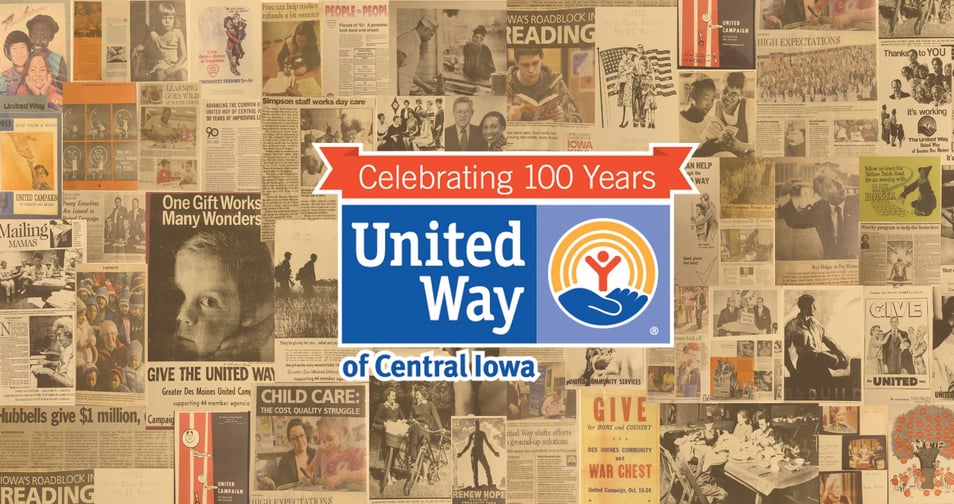
For the past 100 years, United Way of Central Iowa has taken on challenges big and small—from convening the community to tackle tough issues like poverty and getting kids ready for school success to partnering with thousands of people who donate each year to a campaign that makes the work of improving our community possible.
Our history is a testament to our dedicated and compassionate central Iowa community who has engaged in our work for 100 years.
As our 100th year celebrations come to an end, scroll down to sample some highlights from United Way of Central Iowa's past 100 years.
2017: A new century of impact
- Central Iowa is the No. 1 per-capita-giving United Way in the country among those local United Ways raising more than $25 million.
- United Way of Central Iowa celebrated 100 years of service at the Centennial Celebration in January.
2016: 100th Year focuses on mission
- United Way of Central Iowa celebrated its 100th year serving the community.
- United Way of Central Iowa was awarded a $2.2 million grant—the largest in its history—a U.S. Department of Labor America's Promise Grant focused on helping 380 central Iowans find careers in the health care industry.
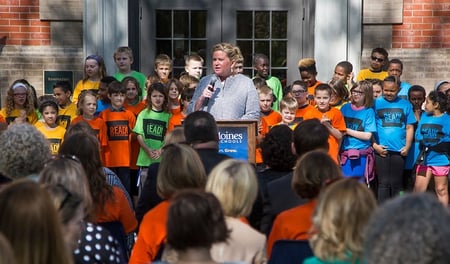
- United Way of Central Iowa launched READ to SUCCEED, a community-wide call to action that focuses on helping central Iowa kids read proficiently by the end of third grade.
- The first annual Refugee Summit celebrated the accomplishments of refugees in central Iowa and raised awareness about the ways they enrich our community.
- Erin Gruwell, author of the bestselling book "Freedom Writers," spoke at the Women's Leadership Connection (WLC) Premier Event about her educational philosophy, which encourages students to rethink rigid beliefs, reconsider their own daily decisions, and ultimately rechart their future.
- The annual Graduation Walk expanded to include middle and high school students with high rates of absenteeism.
- 15,000 pounds of food were donated by 3,000 volunteers in July through a special Pack a Protein Picnic Food Drive, which focused on collecting food items high in protein—a great need for food pantries, especially during the summer months. These donations contributed to feeding the more than 65,000 central Iowans who are food insecure.
- More than 1,200 volunteers completed 3,000 literacy kits for central Iowa’s children in June on the longest day of the year. The Literacy Solstice benefited children in 33 United Way-funded programs and educated community members on the importance of children reading proficiently by the end of third grade.
- Working with community partners, United Way of Central Iowa launched 5-2-1-0 and Well Kids of Central Iowa to promote children's health and prevent childhood obesity.
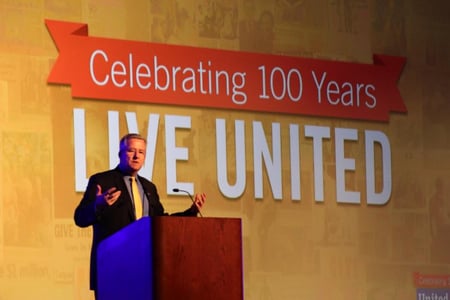 Bridges to Success—a collaboration between United Way of Central Iowa and Des Moines Area Community College—was launched, using innovative strategies to help 10,000 central Iowans achieve their equivalency diploma by 2020 and be on a path to financial stability.
Bridges to Success—a collaboration between United Way of Central Iowa and Des Moines Area Community College—was launched, using innovative strategies to help 10,000 central Iowans achieve their equivalency diploma by 2020 and be on a path to financial stability.- Brian Gallagher, the CEO of United Way Worldwide, gave the keynote address at the annual LIVE UNITED luncheon in April.
2010s: Working toward the community Goals for 2020
- United Way advanced its collective impact work by convening partners around needed systems changes and developing integrated programs to maximize impact and accelerate progress toward the Goals for 2020.
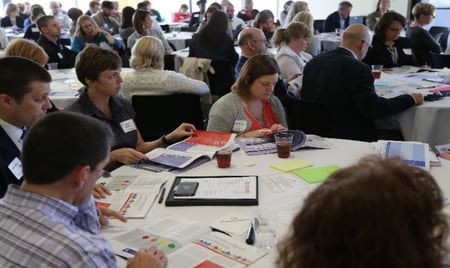 Working with partners in the business, government and nonprofit sectors, United Way of Central Iowa launched OpportUNITY—which is a comprehensive effort for actions that can address the barriers of the one-third of central Iowans who are not financially stable.
Working with partners in the business, government and nonprofit sectors, United Way of Central Iowa launched OpportUNITY—which is a comprehensive effort for actions that can address the barriers of the one-third of central Iowans who are not financially stable.- The HOPE Initiative was founded to work with single-parent families on a pathway out of poverty toward self-sufficiency. In the first year, 25 families were served.
- United Way of Central Iowa reached its Education goal with a 91.7% high school graduation rate. Reaching further, the organization reset the Education goal for 2020 to 95%.
- United Way of Central Iowa began using the Gallup-Healthways Well-Being Index, which tracks physical health and mental and social well-being, to measure the Health goal for 2020.
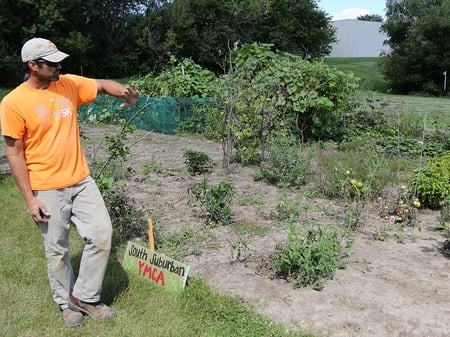 Through advocacy efforts in partnership with Skills2Compete, $12.5 million in state funding was secured for adult basic education and post-secondary career pathway training.
Through advocacy efforts in partnership with Skills2Compete, $12.5 million in state funding was secured for adult basic education and post-secondary career pathway training.- LeadershipLink, an online tool to connect individuals with board and other volunteer leadership roles, was launched in partnership with the Community Foundation of Greater Des Moines and the Regional Leadership Council.
The first corporate giving gardens, run by employee volunteers at local partner companies, were created. - United Way of Central Iowa was one of eight local communities chosen to provide financial counseling for low- and moderate-income families through the Financial Capability Network, sponsored by Wells Fargo.
2000s: Collective impact model, affinity groups launch
- United Way of Central Iowa set bold Goals for 2020 in education, income, and health—the public launch of the collective impact model that unites donors, volunteers, companies, nonprofits, government, and others to make real and lasting change.
- The first Graduation Walk enlisted volunteers to encourage high school dropouts and struggling students to graduate.
- United Way of Central Iowa took the lead in managing VITA, which provides free tax assistance to central Iowans makeing $58,00 or less.
- United Way of Central Iowa opened a volunteer reception center in response to flooding in the community.
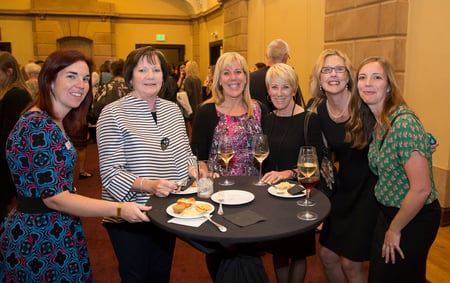 The database listing community-wide volunteer opportunities went online.
The database listing community-wide volunteer opportunities went online.- First Call for Help transitioned to 2-1-1 as we know it today.
- The Women’s Leadership Initiative (now Women’s Leadership Connection) was launched to improve the lives of children and their school readiness.
- The Women’s Leadership Initiative was recognized by United Ways of America as the best new women’s program one year after its launch.
- The Emerging Leaders Initiative (now Education Leadership Initiative) was launched to support school success during the middle-school years.
- A student-led United Way began at Drake University and included an Alternative Spring Break.
- The annual campaign surpassed $25 million for the first time.
- United Way of Central Iowa partnered with the Community Foundation to develop Board Connect, which provides board training for community leaders.
- United Way International and United Way of America came together to create United Way Worldwide, the largest privately-funded nonprofit in the world, with more than 1,800 United Ways in 41 countries and territories.
1990s: Education, income, and health emerge as priorities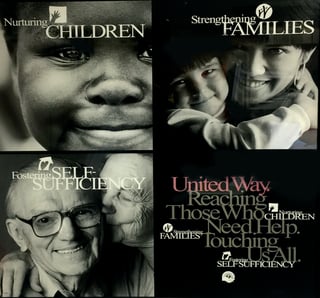
- Focus areas included: education and children's success in school, income issues, children's well-being, labor, and First Call for Help (the forerunner to United Way 2-1-1).
- The first public policy platform established United Way of Central Iowa as a credible resource advocating for health and human services.
- The first annual Day of Action—when employees from local companies spend time volunteering in the community—was held.
- The annual campaign surpassed $10 million for the first time.
1980s: Giving makes an impact
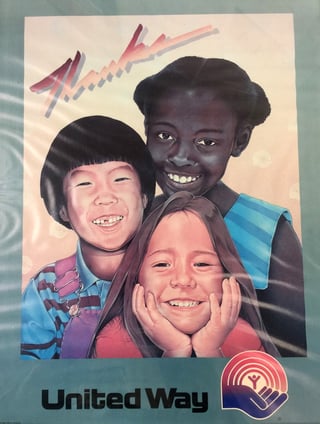 United Way of Central Iowa opened the Human Service Campus on 9th Street in Des Moines, its current location.
United Way of Central Iowa opened the Human Service Campus on 9th Street in Des Moines, its current location. - The Principal Financial Group became the first Iowa-based company to raise more than $1 million in a single fundraising campaign.
- United Way of Central Iowa was one of five communities to form an Alexis de Tocqueville Society, recognizing annual contributions of $10,000 or more.
- Giving increased 8.6% in one year.
- Maddie Glazer (Levitt) became United Way of Central Iowa’s first female campaign chair.
- The Information and Referral phone center handled 1,300 calls a month.
- United Way of Central Iowa collaborated on Community Service Sentencing program.
- The Human Services Resource Directory was produced to collate local resources for people in need of assistance.
- United Way of Central Iowa was adopted as the organization’s official name.
- United Way postage stamp issued for United Way of America’s 100th Year
1970s: Volunteering takes off
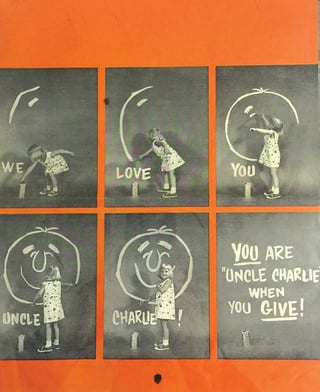 A new data processing computer was installed.
A new data processing computer was installed.- United Way responded to a critical shortage of quality child care in the community.
- The RSVP senior volunteer program began.
- The organization holds a Volunteer Week with recognition activities at Younkers in appreciation of their innovative Volunteer Time Off (VTO) policy.
- The “How does your garden grow?” training was developed to help nonprofits manage volunteers.
- The organization's name was changed to United Way of Greater Des Moines.
- United Ways of Iowa—the organization representing all local United Ways in the state—met for the first time.
- American and Canadian United Ways raised more than $1 billion—the first time in history that an annual campaign of a single organization raised that much.
- The NFL and the national United Way established their partnership to increase public awareness of social service issues facing the country.
- Local United Ways began using United Way's now-famous “hand” logo.
1960s: Poverty and essential needs become priorities
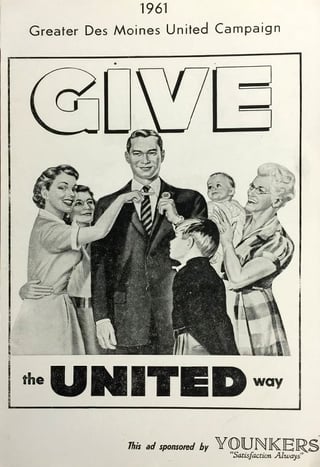 United Way launched a “war against poverty.”
United Way launched a “war against poverty.”- A community-wide audit of local services occurred to ensure that all needs were being addressed.
- An information and referral phone center, the forerunner to United Way 2-1-1, was established.
- Ann Landers appeared as the special guest of the women’s division campaign kick-off rally to boost involvement and offset the decline in women’s participation in the residential, home-to-home solicitation—the result of more women in the workforce.
- The board of directors increased support to the USO due to expanded operations in Vietnam.
- The board adopted a “statement on discrimination,” to prevent discrimination on the basis of race when hiring employees or serving clients. It was applicable to United Way staff and member agencies.
- The first volunteer recognition event was held.
- With the help of Farm Bureau Insurance, campaign records were computerized for the first time.
- Drake University students conducted a successful campaign—the first time this student group participated.
- The organization broadened to include all of Polk County.
- The city of Norwalk joined the campaign.
- The organization's name was changed to Greater Des Moines United Way.
- The organization celebrated 50 years of service.
1950s: Unity throughout the community
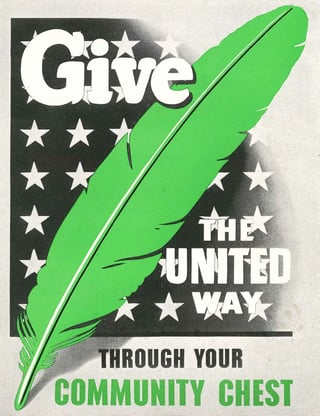 The words “United Way” appeared officially for the first time: “Give the United Way through your Community Chest.”
The words “United Way” appeared officially for the first time: “Give the United Way through your Community Chest.”- United Community Services became the organization’s fifth official name.
- The first united campaign of Greater Des Moines is coordinated to address multiple fundraising drives. The cornerstone participants included Community Chest, Polio Fund of Des Moines, American Red Cross, USO, and others.
- The campaign surpassed $1 million for the first time.
- The first team of Loaned Executives from local companies helped with workplace campaigns.
- Payroll deductions were introduced for the annual campaign.
- The organization moved into the new, state-of-the-art Hawley Welfare Building at 700 6th Ave. in Des Moines.
- United Fund became the organization's fourth official name.
- A full-time labor liaison was hired.
- Key focus areas included: "mentally maladjusted children and the need for the Child Guidance Center" (the forerunner to Blank Children’s Hospital).
- The national organization (United Community Funds and Councils) adopted the Jiminy Cricket character from Disney's "Pinocchio" as part of a radio, television and print campaign.
- Year-round visibility becomes important for the organization as television transforms society.
1940s: The war drives donations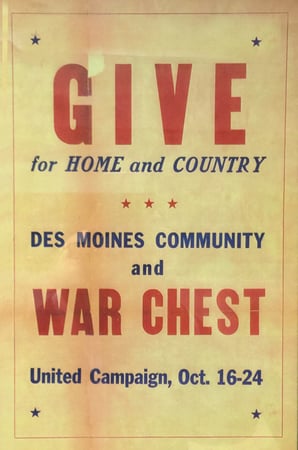
- More than 1,000 communities had established United Way organizations.
- During WWII, Community Chest focused on both social services and the war effort.
1930s: Relief from the Great Depression
- Every campaign during the Great Depression exceeded its goal.
- At the height of the Depression, the Council of Social Agencies and a Social Planning department were established as part of the Des Moines Community Chest to coordinate public, private, and governmental efforts in providing social welfare services.
- 25,000 people—one out of every six Des Moines residents—received support from organized relief agencies.
- Des Moines ranked No. 4 nationally of 405 community chests.
- Community Chest of Des Moines was adopted as the new name for the organization.
- Community Chest of Des Moines partnered with the Salvation Army to help people on relief lists.
- Community Chest helped to launch the local tradition of children telling a joke during "Beggars Night," as a way to divert youth vandalism that was on the rise at the time.
1920s: A leader in health and human services
- Focus areas included: institutions for children, serving and aiding dependent families, and agencies providing services and homes for the poor.
- From the Annual Report: “Des Moines, together with less than half a dozen other cities, is known as one of the pioneers in bringing about a financial federation of its welfare work."
1910s: Joining together for the common good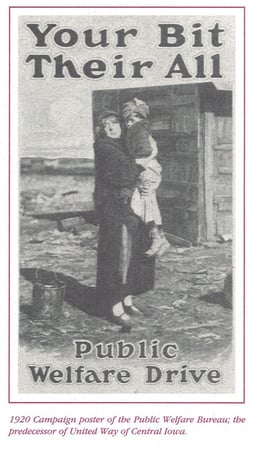
- On February 14, 1917, a group of local charities organized a joint committee called the Des Moines Public Welfare Bureau. That organization evolved over the next century into United Way of Central Iowa.
- The first fundraising campaign raised $92,003 ($1.7 million in today’s dollars) under the leadership of J.K. Elwell, benefiting 24 local charities.
- The Three-in-One Campaign raised $200,000—$80,000 of which is earmarked for Armenian and Syrian and Jewish War Relief Funds.
- As reported at the Annual Meeting in 2019: $800 per year was the minimum decent living wage for a man with a family of 6; Iowa was one of six states with no minimum wage law for women; in low-income families, 230 out of every 1,000 babies died, mostly from malnutrition. United Way established free health centers and food pantries to address the issue.
CTA Headline Goes Here Lorem Ipsum Dolor Sit Amet
Lorem ipsum dolor sit amet consectetur. Quis congue varius a.